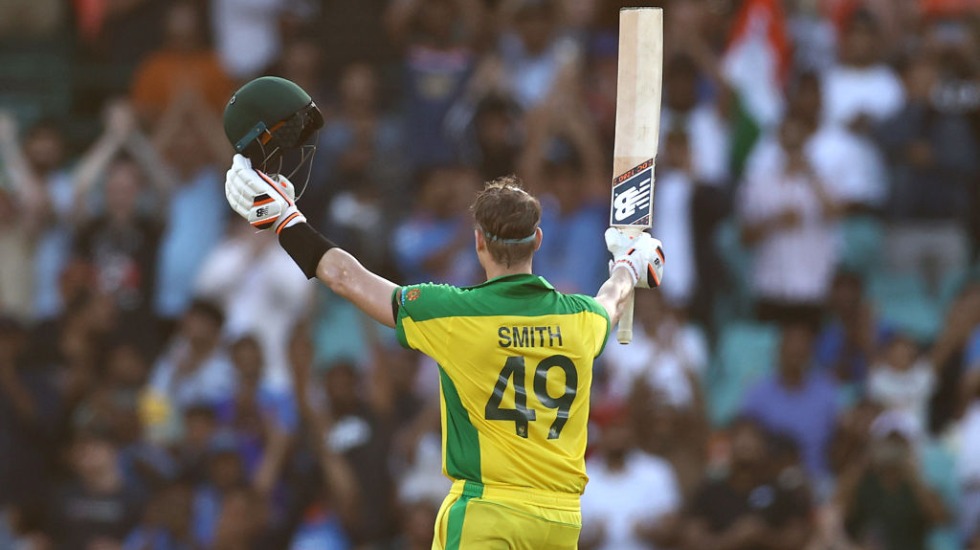Australia’s Steve Smith celebrates his century in the first ODI between Australia and India last week. Photo: GETTY IMAGES.
While the summer of cricket finally launched in sizzling Sydney conditions last weekend, Cricket Australia’s relationship with its free to air partner, Channel 7, has never been frostier.
All has not been well between the two parties for some time now, with Seven demanding a significant discount on the $70 million annual fee it pays as part its deal to cover their share of the summer’s cricket fare.
Seven believes the 2020/21 product served up by Cricket Australia is not what it purchased, and while acknowledging that Covid-19 has had some role to play, it is Cricket Australia’s scheduling of the summer that has the network crying foul the most.
To maximise ratings and momentum, Seven wanted the season to start with a bang, with a “fast start” which would have included the launch of the BBL season on the same day as the originally-scheduled first Test on December 3. The network also expected three Test matches before Christmas.
Instead, it claims Cricket Australia kowtowed to the demands of India and launched the season with six white ball matches – all covered exclusively by Fox Sports.
Undoubtedly, Cricket Australia’s decision to launch the season with three one-day internationals behind a paywall has its consequences.
Yes, ratings on Fox Sports and Kayo were outstanding, with the audiences climbing to 470,000 on Friday night and over 585,000 on Sunday night. Indeed, Sunday’s second ODI between Australia and India was the most-watched ODI ever in subscription television history.
But here’s the thing. If Cricket Australia launched the season with a Test match beaming across the nation on free-to-air television, there’s little doubt the audience would have been three times higher.
If the Big Bash started at the same time, it’s likely Cricket Australia would have a week full of one million-plus audiences watching a game each night.
As Seven’s boss, James Warburton put it: “There aren’t many sports that would launch their season behind a paywall.”
The game is selling itself short, too. If you want to be on the minds and in the conversations of Australians in pubs, worksites, boardrooms, zoom meetings and loungerooms across the nation, you need to be seen by the masses.
The bottom line remains that as high as were the Fox Sports ratings were from the first two ODI’s, they were capped by the fact only 4.94 million Australian households subscribe to Foxtel and Kayo.
PLEASE HELP US CONTINUE TO THRIVE BY BECOMING AN OFFICIAL FOOTYOLOGY PATRON. JUST CLICK THIS LINK.
With mass audiences and high ratings comes momentum, which then translates into even higher ratings and, for the broadcast partners, higher advertising revenues and the opportunity to promote their other programs to more people. It’s then they get to make their money.
Sporting organisations shouldn’t forget that sport is expensive to produce. Channel Nine was making a $30-40 million loss from covering cricket in the final years of its deal.
Free-to-air broadcasters will only be willing to fork out large sums of money to exclusively broadcast the game if they can make a buck back along the way. Furthermore, they expect the sports to help them.
Some sports do this better than others. Could you imagine the AFL launching its season behind a paywall? Not a snowflake’s chance in hell. The league prefers to whip its fans into a frenzy and launch the season with consecutive nights of free-to-air footy with audiences of one million-plus.
You might argue that Cricket Australia had no choice. Once it decided to start the season with three ODI’s and three T20’s, it had to launch it on Fox as the pay TV provider has the exclusive rights for these white ball matches. But why not launch with your biggest and best product?
It’s also worth remembering that together Nine Entertainment and Network 10, who helped build the BBL into a powerful commercial product for Cricket Australia, reportedly offered to purchase the rights to all forms of the game for over $900 million at the last rights negotiations.
Had their offer been accepted it would have meant last weekend’s games would have been accessible to all Australians who own a TV.
Instead, Cricket Australia took the $1.2 billion from Fox Sports with Seven coming on board as the free to air partner.
The fact Cricket Australia took the money means that it now has to strategise how to satisfy two broadcasters, not one, and so far, it appears to be failing miserably.
The other issue is the promotion of the game. Logic says that if you can launch your season with your best players playing the premium form of the game with millions of people watching on TV, then you should.
Seven believes Cricket Australia could have, but didn’t. And this means that Cricket Australia might be playing catch-up for the rest of the summer.











